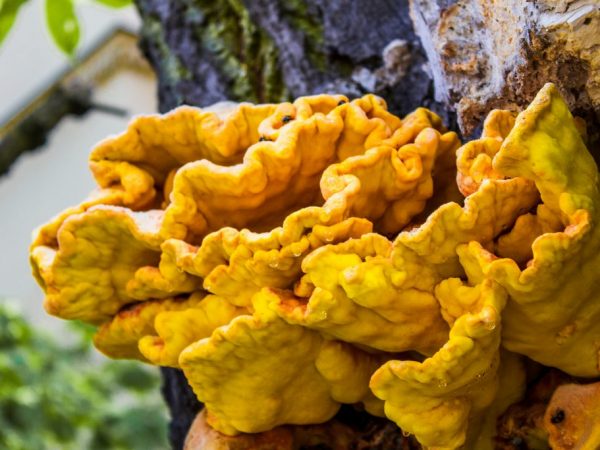Description of the sulfur-yellow tinder fungus
Tinder fungi are attached with a stem or fruiting body to dead trees or stumps. Most of the species of these mushrooms are not eaten, but there are edible ones among them. The sulfur-yellow tinder fungus also has medicinal properties.

Description of the sulfur-yellow fungus tinder fungus
Description of tinder fungus
Representatives of the Tinder fungus group or Tinder fungi can significantly outrun their counterparts in the Kingdom of Mushrooms, belonging to other ecological or systematic groups, in size. Some varieties can have a fruiting body up to 1 m long and weigh up to 20 kg. They grow mainly in mixed forests. The period of their collection falls on the beginning of July - the end of September.
Tinder fungus sulfur-yellow or chicken mushroom, or chicken mushroom belong to the Polyporous family of Basidiomycetes. Most of them have annual fruiting bodies, but there are also species for which perennials are characteristic, because it takes several years to form a full-fledged fruiting body. They have a tubular hymenoform with a harsh pulp and a bark-like surface. Their color is varied: light gray, white, sometimes yellow and black.
Tinder fungus species similar in edible or medicinal properties
Most of the representatives of the Polypore mushrooms group do not eat. They are not poisonous, but in terms of their taste, they are not suitable for preparing culinary dishes. An important advantage is their unique medicinal properties. The most common edible species are:
- tinder fungus or larch;
- m. flat or sulfur-yellow;
- t. varnished (Reishi mushroom);
- t. umbrella;
- t. birch.
Distinctive features
The sulfur-yellow tinder fungus has a fruiting body ranging in size from 6 to 30 cm and weighs up to 10 kg or more. In a young specimen, the color is intense yellow, the shape is flowing, consisting of pseudo-caps, fused together, and wavy edges along the entire perimeter. From above it is covered with beige fluff. The flesh of a young mushroom is juicy and has a sour taste. With age, it becomes hard, brittle, with an unpleasant odor, and beetles attack it.
Irina Selyutina (Biologist):
At the initial stage of development, the young fruiting body is characterized by the so-called. "Flowing form" - when it really in its appearance resembles an influx or teardrop-shaped fleshy mass. After a while, transformation processes begin, as a result of which the fruiting body gradually hardens and its shape becomes reminiscent of an ear. In young mushrooms, the pulp is juicy, white, brittle and has a pleasant sour taste. The smell is also pleasant - lemon, but in old mushrooms it already resembles the smell that remains after mice. The tubular hymenophore of young fungi emits a yellowish aqueous liquid in the form of droplets.
Only young mushrooms are eaten, old ones can cause poisoning.
A sign of suitability for use is the droplets of yellow liquid released from the pores on its surface.
It has an external similarity with the inedible mushroom climacodon northern and edible meripilus giant. However, the former differs from the tinder fungus in its dark brown color; the latter has small thin thorns on the cap.
By the way. A variety of chicken mushroom (Laetiporus conifericola) growing on conifers is sometimes even considered as an independent species. However, it is indicated that it cannot be eaten, unlike the form of the sulfur-yellow tinder fungus (Laetiporus sulphureus), which affects deciduous trees, because this can provoke mild poisoning in children.
Healing properties

The fungus is used to make antibiotics
The mushroom has analgesic, antiseptic and hemostatic properties. In modern medicine, it is the source for the production of a number of antibiotics used to treat staphylococcus and other bacterial infections. Also, medications based on it treat diseases of the liver, biliary tract and respiratory organs, increase immunity and improve the metabolism of substances.
Main directions of use:
- treatment of malignant and benign tumors;
- treatment of diseases of the heart and lungs;
- with allergies and autoimmune disorders;
- with metabolic disorders, alcohol dependence, epilepsy.
In folk medicine, it is used as a laxative and a treatment for dysbiosis.
Cooking applications
Sulfur-yellow tinder fungus is considered edible, its use in cooking is quite diverse. The flesh of young individuals is tender and juicy with a yellow tint, and for its peculiar taste it is called "forest chicken". They are good marinated, boiled or fried for use in salads. They are also used for filling pies, casseroles and just hot snacks.
In order not to harm the body, you should try not to use overripe fruiting bodies, so you need to be careful when collecting them. The use of such a product in food can provoke nausea, vomiting, swelling of the oral mucosa, an allergic reaction and even hallucinations.
Irina Selyutina (Biologist):
As medical practice shows, the ailments that can be caused by eating in some hypersensitive people do not entail such negative consequences as after eating poisonous mushrooms. However, it is believed (so far only assumptions are being made) that specimens of sulfur-yellow tinder fungus collected from the trunks of coniferous or poisonous (for example, yew) trees may serve as the reason for this. Therefore, for lovers of "forest chicken meat" there are restrictions:
- Collect only young mushrooms: soft, no unpleasant odor.
- Collect mushrooms that have grown only on deciduous trees. Do not touch specimens developing on conifers, or even more so on representatives of poisonous woody plants.
Moreover, these mushrooms will not benefit children or pregnant women.
Conclusion
In general, the tinder fungus can be attributed to the orderlies of the forest, because, settling on dead trees, it gradually processes them, turning them into nutrients that saturate the soil. Its use in traditional and folk medicine makes it invaluable and unique among other types of mushrooms.



